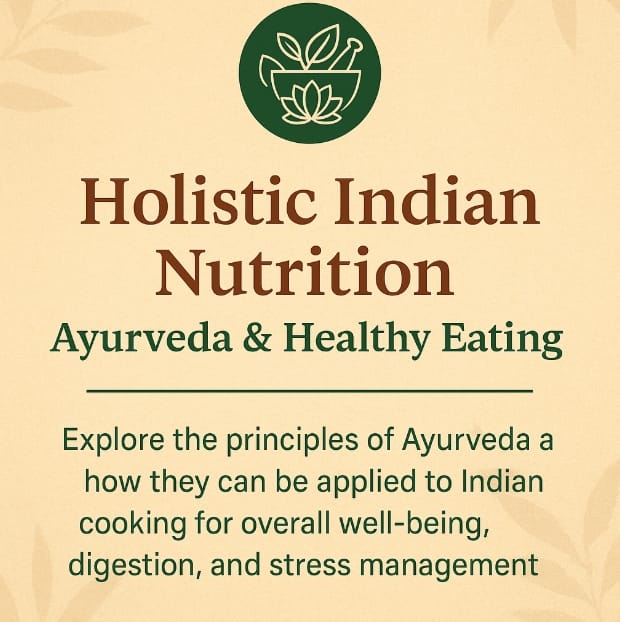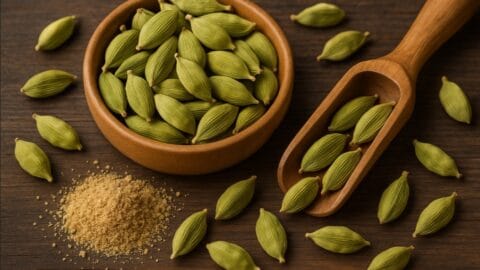In today’s fast-paced world, many seek wellness through food. Indian culture offers an ancient, time-tested system called Ayurveda, which means “science of life.” By aligning with its principles, your everyday Indian nutrition cooking can become a path to improved digestion, stress relief, and total well-being.
What Is Ayurveda?
Ayurveda is a 5,000-year-old holistic healing system from India. It views food as medicine and emphasizes balance in three doshas—Vata, Pitta, and Kapha. These energies govern physical and mental processes. Each person has a unique dosha combination, and tailoring food choices to your dosha promotes harmony.
Key Principles of Ayurvedic Nutrition
Ayurvedic eating isn’t just about ingredients—it’s about how, when, and why you eat. Here are core principles:
- Eat according to your dosha type.
- Favor freshly cooked, seasonal foods.
- Use herbs and spices like turmeric, ginger, and cumin to aid digestion.
- Eat mindfully and in calm environments.
- Balance all six tastes—sweet, sour, salty, bitter, pungent, and astringent—in every meal.
These guidelines support physical energy, mental clarity, and emotional balance.
Applying Ayurveda in Indian Cooking
Traditional Indian meals naturally reflect Ayurvedic wisdom. Here’s how to integrate it practically:
1. Cook with Digestive Spices
Spices such as hing (asafoetida), ajwain, and fennel help reduce bloating and indigestion. Including these in tadka (tempering) balances Vata and improves gut health.
2. Use Ghee as a Healthy Fat
Ghee nourishes all tissues, supports digestion, and is considered sattvic—promoting clarity and peace. Unlike processed oils, ghee enhances nutrient absorption.
3. Focus on Seasonal and Local Vegetables
Eating in sync with nature—cooling foods in summer (like cucumber, mint, coconut) and warming in winter (like root vegetables and warming spices)—keeps the doshas in check.
4. Avoid Combining Incompatible Foods
Ayurveda discourages mixing milk with fruits, or yogurt with meat. These combinations can lead to ama, or toxins, that impair digestion.
5. Embrace Herbal Teas and Warm Water
Sip on cumin-coriander-fennel (CCF) tea or ginger tea between meals to stoke digestion and reduce bloating. Avoid cold drinks, which can extinguish digestive fire (Agni).
Ayurvedic Meal Routine for a Balanced Day
| Time | Meal | Tips |
|---|---|---|
| 7–9 AM | Warm breakfast like spiced porridge or upma | Supports Kapha balance |
| 12–1 PM | Largest meal with all six tastes | Pitta is strongest—digestion at peak |
| 6–7 PM | Light dinner such as khichdi or soup | Keeps digestion smooth for better sleep |
Eating at consistent times also helps regulate the body’s rhythms and reduce stress.
Ayurveda’s Role in Stress Relief
Mental stress disrupts digestion and immunity. Ayurvedic foods—especially sattvic ones like mung dal, fresh vegetables, and warm milk with nutmeg—can calm the nervous system. Combining this with breathing practices (pranayama) and herbs like ashwagandha boosts resilience.
Final Thoughts: Eating for Mind-Body Harmony
Ayurveda isn’t a strict diet—it’s a lifestyle. Indian food already carries this wisdom. By eating mindfully, honoring your dosha, and choosing whole, spiced, and balanced meals, you can turn daily cooking into a healing ritual for your body, mind, and soul.
FAQs
Q1: How do I know my Ayurvedic dosha?
You can consult an Ayurvedic practitioner or take a reliable online quiz to discover your dominant dosha.
Q2: Can I follow Ayurveda if I’m vegan?
Yes, but you’ll need to replace ghee with oils like sesame or coconut and adjust some recommendations.
Q3: Is Ayurveda scientific?
Ayurveda is rooted in observation and empirical knowledge. Many principles, like circadian eating and digestive spices, are now backed by modern science.





